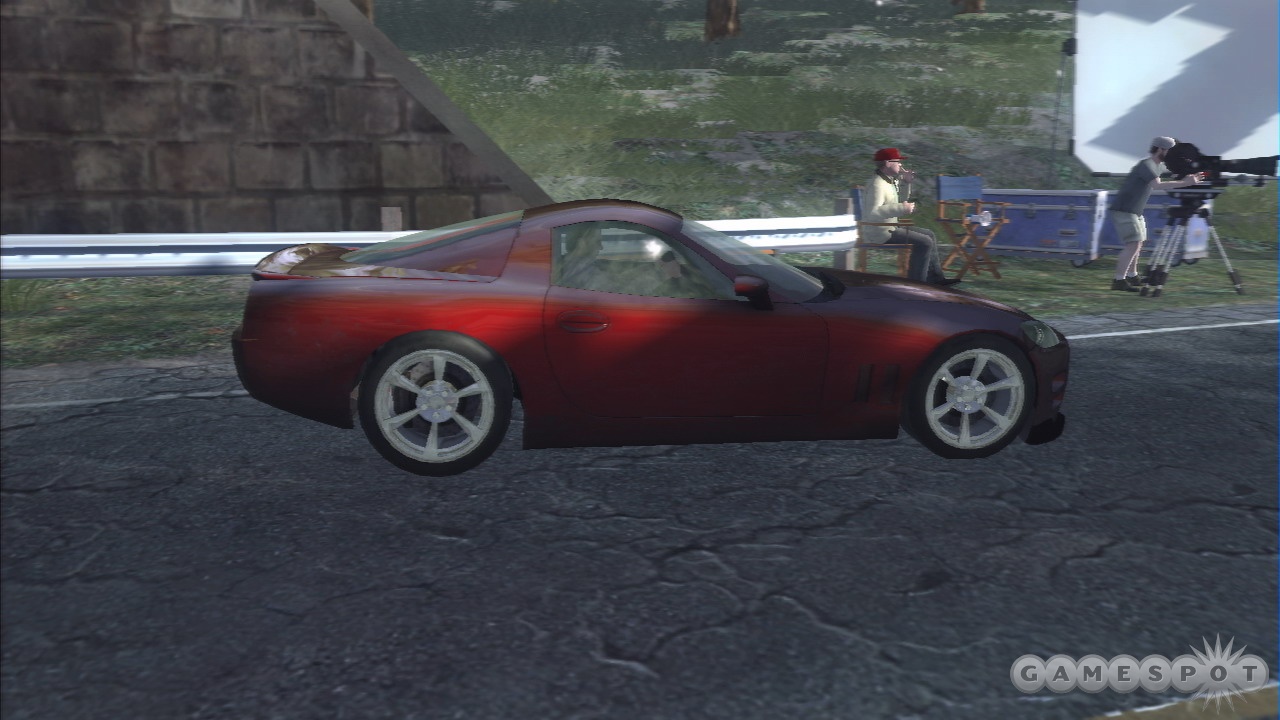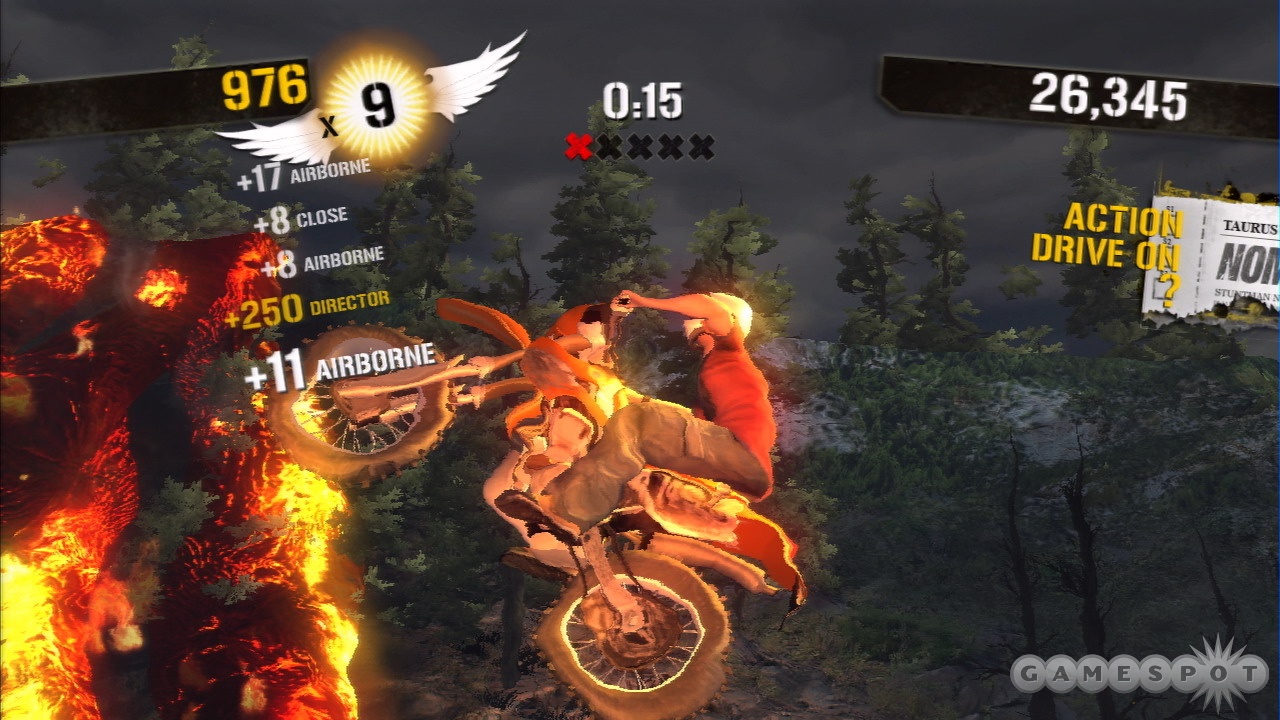The original Stuntman was a polarizing game when it crash-landed on the PlayStation 2 more than five years ago. The notion of playing the part of a Hollywood stunt driver seemed universally appealing, but the game's exceedingly low threshold for missteps meant you had to play through lengthy stunt sequences repeatedly before you got them right and could advance to the next sequence. The game's winking take on Hollywood blockbusters and the satisfaction of really nailing a stunt sequence made it all worthwhile for some folks, but others found it supremely frustrating. Paradigm has taken over development duties on the new sequel, and Stuntman: Ignition is definitely a more dynamic, more approachable game than its predecessor. It's still Stuntman, though, and you'll still need a certain tolerance for trial and error.

The career mode in Ignition puts you in the role of a no-name commercial stuntman trying to work his way up. Your first movie job is on the egregiously titled volcano disaster movie Aftershock, and if your performance is up to snuff, you'll go on to work on the hillbilly action sequel Whoopin' and a Hollerin' II; Strike Force Omega, the directorial debut of action star Karl Steele; the pulpy '70's cop movie Overdrive; Never Kill Me Again, the latest in a glossy, long-running spy series; and the dark, comic-book-inspired Night Avenger. Ignition's film parodies work because they're specific in what films they're targeting while also satisfying many broad Hollywood conventions. Certain touches add to the fun, such as the stereotypical personalities of the different directors and the trailers for the movies you're working on.
You'll have to take on six individual stunt sequences for each film you work on, and each sequence goes on for several minutes. The sequences take place on big, serpentine sets dense with explosions, other stunt drivers, crumbling buildings, and crazy set pieces, and you'll have to navigate these big-budget obstacle courses while hitting specific stunts and keeping up the pace. Your stunts are flagged onscreen with large yellow icons, and your stunt coordinator will also be calling them out as you approach them. You'll take jumps, drive on two wheels, perform barrel rolls, pull wheelies, drift around corners, bump into other cars, crash through props, chase other stunt drivers, and more. In addition to your vehicle's innate abilities, there's the action button, which you'll use at specific points to trigger events like explosions, weapon fire, a quick burst of nitro, or sliding your motorcycle under an obstacle.
More often then not, the screen is filled with activity, which can make the action feel really kinetic, but can also make it difficult to see where you're supposed to go next. This can be frustrating, especially since the acceptable margin of error in Stuntman: Ignition is so thin. Miss a stunt and you'll get a strike; get five strikes, and you'll have to reshoot the whole sequence from scratch. There are other autofail conditions, like plunging your vehicle into water or hot lava, driving off the set, or falling too far behind during a chase sequence. Fast reaction times are critical in hitting a series of stunts one right after the other, but ultimately, each and every sequence you'll take on will feature twists and turns that you simply cannot anticipate and will require a certain level of memorization--though this could also be said for just about any other racing game. On the upside, the load time when restarting a sequence is almost instantaneous. Regardless, the inherently repetitive structure of the game will leave some folks cold.
You're scored for your performance on each stunt sequence, and then assigned a star rating based on that score. Your progress from one movie to another is throttled by your accumulated star rating, though the star rating requirements on the first few movies are pretty easy; you'll be able to scrape by with plenty of two-star performances. Eventually, though, you'll have to revisit stunts to improve your star rating. While making good time and hitting your stunts are necessary to progress--as well as good ways to score points--the real key to higher scores is stunt stringing, which isn't entirely dissimilar from the boost system in the Burnout games, for example.
Performing stunts in quick succession will start a stunt string, and the score for the stunts within that string will be multiplied by the number of stunts within that string, for as long as you can keep the string going. This requires lots of relentlessly risky behavior like having close calls with obstacles and other vehicles and drifting into turns as you make your way from one predefined stunt to another to keep the string going. The stunt string system is interesting, and it's significant to the lasting value of Stuntman: Ignition, because it adds a level of dynamism to what is otherwise pretty static gameplay. If it were just a matter of hitting your marks, it would get old much sooner.
If you're still having a hard time raising your accumulated star rating by replaying previous stunts, you can also take on odd jobs, such as participating in a stunt-driving exhibition at an amusement park, or working on a TV commercial. While generally shorter than the average stunt sequence, the odd jobs are even more unforgiving, as a single strike against your performance will end it. You can play through every last stunt sequence in the career mode in a few hours, though it will take you significantly longer than that if you want to wring a five-star rating out of every stunt sequence. Every five-star rating requires you to maintain a single stunt string over the entire stunt sequence, so good luck with that.
Outside the career mode there's a multiplayer mode, which includes two different race types. Backlot battle focuses on performing as many stunts as possible within a set number of laps, while the backlot race mode is a more straightforward race where you can earn bursts of nitro by doing stunts. With eight-player online support on the PS3 and Xbox 360, these modes can get real chaotic, though a short number of tracks curbs the lasting appeal. There's also a simple course constructor that lets you lay down your own obstacle course, as well as some stand-alone stunt sequences. It's not a hugely expansive game, but it's the kind of game you can easily lose a weekend to.

Stuntman: Ignition is currently appearing on the PlayStation 2, PlayStation 3, and Xbox 360, and the differences among them are about what we've come to expect. The PS3 and Xbox 360 versions are pretty comparable, though the PS3 version features motion-based controls that are thankfully optional, as well as a little more aliasing. The graphics are still pretty sharp across the board. There's loads of detail in the vehicles, and the environments and the explosions look nice, though looking at the bigger picture, what's really good about the visuals is how fully realized the visual style for each movie is. The frame rate isn't always stable, and if you look beyond your immediate surroundings you might notice some nasty textures, but these aren't critical issues. On the PS2 there's an appropriate drop in visual fidelity, which means less texture detail, fewer cars on the road, and things of that nature, though it's still a decent-looking game. The online functionality of the multiplayer has been stripped out of the PS2 version, though. Surprisingly, the PS2 version actually loads faster than the PS3 or Xbox 360 versions.
It's difficult to judge the quality of the sound effects in Stuntman: Ignition, because they are almost always drowned out by the constant shouting of your stunt coordinator. The voice work isn't bad per se, it's just that he shouts the exact same things at the exact same intervals on any given stunt sequence, and having to hear it over and over again can be a little crazy-making. For what it's worth, though, there's some nice, thematically appropriate music that accompanies each movie.
Stuntman: Ignition is a significant step up from its predecessor, and it's a pretty distinct experience as far as driving games go. The fundamental structure of playing through the same stunt sequence repeatedly will no doubt sour some, but if you can get past that, it can be a blast.